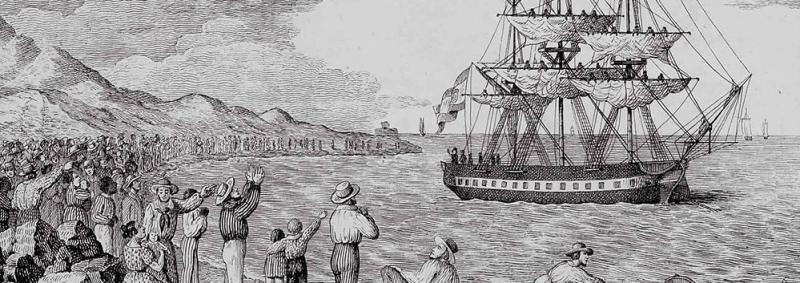 Today, the first doses of the Pfizer-BioNTech Covid-19 vaccine have begun to be distributed in the United States. It seems like a good time to look back at the voyage of the orphan boys in the vaccine ship that sailed from Spain in 1803.
Today, the first doses of the Pfizer-BioNTech Covid-19 vaccine have begun to be distributed in the United States. It seems like a good time to look back at the voyage of the orphan boys in the vaccine ship that sailed from Spain in 1803.
Now know as the Balmis Expedition, it was officially called the Real Expedición Filantrópica de la Vacuna (Royal Philanthropic Vaccine Expedition) and was a three-year mission, from 1803 to 1806, to Spanish America and Asia led by Dr. Francisco Javier de Balmis with the aim of vaccinating millions against smallpox. It was the first large scale mass vaccination of its kind.
In 1798, Edward Jenner developed a vaccine against smallpox. He had observed that those infected by the cowpox virus were immune to smallpox. Cowpox was a fairly mild ailment whereas smallpox was a contagious and deadly disease, causing the deaths of 20–60% of infected adults and over 80% of infected children. A vaccine against smallpox literally saved millions of lives. (The word vaccine itself comes from the Latin word “vacca” meaning cow, reflecting its origins from a virus affecting cows.)
After his daughter had died of smallpox King Charles IV of Spain sent his court doctor on a mission to vaccinate Spanish America and Asia against the scourge of smallpox. A major outbreak of smallpox in the Spanish colonies was raging and represented both a humanitarian and a political disaster.
But, there was a problem. The vaccine required live cowpox virus. It was unclear how to keep the virus alive during a long ocean voyage.
Cowpox was easily spread from one person to another. A person infected with cowpox effectively carried the smallpox vaccine in his or her blood. However, the person’s immune system would fight off the infection in a relatively short time, providing immunity, but negating the value as a vaccine.
Spanish doctors came up with the idea of serially infecting one person after another so the vaccine would remain viable in at least one person’s blood at the end of the voyage. Balmis had a hard time recruiting cowpox carriers, however. He finally found an orphanage, Casa de Expósitos, in Coruna where he “recruited” 22 orphan boys, aged 8 – 10.
The expedition sailed on Maria Pita, a Spanish corvette, on November 30, 1803, carrying the orphan boys, Balmis, a deputy surgeon, two assistants, two first-aid practitioners, three nurses, and Isabel Zendal Gómez, the rectoress of the orphanage.
Over the next three years, the expedition would bring the vaccine to the Canary Islands, Colombia, Ecuador, Peru, Mexico, the Philippines, and China. In New Spain, Balmis took 25 orphans to maintain the infection during the crossing of the Pacific. Everywhere they traveled, they established “vaccination boards” to continue the vaccinations, educate the local populace, and to manufacture more vaccines.
As Carlos Franco-Paredes, Lorena Lammoglia, and José Ignacio Santos-Preciado wrote in the Oxford Academic journal, Clinical Infectious Diseases:
King Charles IV’s vaccination campaign was visionary, occurring almost 150 years before the World Health Organization and 100 years before the Pan-American Health Organization were established. The success of the expedition was due not just to the heroic perseverance and dedication of those who took part in it, but also in their foresight and focus on public education and the use of local molders of public opinion to help get the message across….
Historic achievements, such as this smallpox vaccination mission, should inspire the ongoing international efforts to control the plagues of our time.

Suddenly, -70C doesn’t seem quite so extreme.
Fascinating story, thanks for publishing Rick.
Rick very timely and shared to our facebook group, USMM in Peace and War. Please check us out.
What a wonderful and timely post today. It would be a great thing to send this story to national newspapers and network news teams to really drum up support for people getting vaccinated against Covid.
I also want to give you props for holding onto this story until the covid vaccinations began today in the U.S., perfect timing.
Thanks Rick!
Great story and excellent comments.